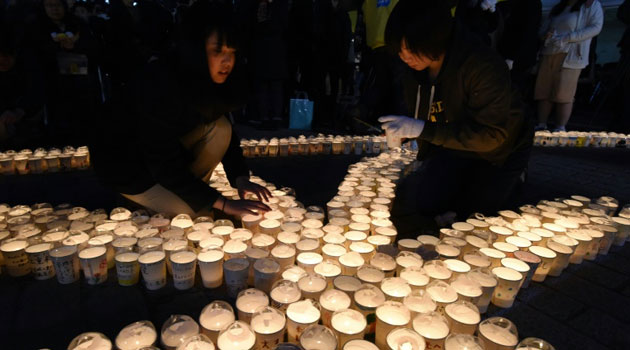
High school students light candles to remember victims of Japan’s 2011 tsunami on March 11, 2016/AFP
TOKYO, Mar 12 – Japan paused on Friday to mark five years since an offshore earthquake spawned a monster tsunami that left about 18,500 people dead or missing along its northeastern coast and sparked the worst nuclear disaster in a quarter century.
Emperor Akihito, Empress Michiko, Prime Minister Shinzo Abe and other participants at a national ceremony in Tokyo bowed their heads along with residents across the affected region at 2:46 pm (0546 GMT) the exact moment on March 11, 2011 the magnitude 9.0 quake struck under the Pacific Ocean.
The massive earthquake unleashed a giant wall of water that swallowed schools and entire neighborhoods, with unforgettable images of panicked residents fleeing to higher ground and vehicles and ships bobbing in the swirling waters of flooded towns.
The waves also swamped power supplies at the Fukushima Daiichi plant, causing reactor meltdowns that released radiation in the most dangerous nuclear disaster since Chernobyl in 1986.
In the northern city of Sendai in Miyagi prefecture — the region that suffered the most deaths — survivors and bereaved relatives gathered at a Buddhist statue built for the repose of victims’ souls in front of a huge breakwater at Arahama beach where massive waves crashed ashore five years ago.
Some joined hands in prayer, while a woman threw a bouquet of flowers into the sea.
Police and firefighters were seen combing beaches along the Pacific coast in continuing efforts to find evidence of victims, including bones, as many families say they still cannot abandon hope of seeing their loved ones again.
Besides the number of people killed in the quake and tsunami, about 3,400 deaths from causes such as illness and suicide have been linked to the aftermath of the tragedy.
In remarks at the solemn event in Tokyo inside the National Theatre, 82-year-old Akihito spoke of those who were forced to evacuate after the disaster because of nuclear contamination.
“I feel pain in my heart when I think of people who still could not return home,” he said.
The crisis forced tens of thousands of residents near the stricken plant to flee their homes, farms and fishing boats. Some areas remain uninhabitable, though in others residents have been cleared to return.
As night fell in Sendai, residents gathered at a park where thousands of candles were arranged on the ground to form the Japanese-language phrase “toward the future light”.
– ‘Cold shutdown’ –
The situation remains fragile in Fukushima prefecture, where the nuclear plant suffered explosions that spread radioactive material into the surrounding countryside and ocean.
Authorities have since brought the reactors to a state of “cold shutdown” and dispatched work crews to cleanse affected houses, sweep streets and shave topsoil in “decontamination” efforts.
Tokyo Electric Power, the operator of the shuttered plant, admits it has only made small steps in what is likely to be a four-decade battle to decommission the crippled reactors.
Japan’s entire stable of reactors was shuttered in the disaster’s aftermath but Abe and utility companies have been pushing to get as many as possible back in operation — despite public opposition and legal hurdles — saying they are essential to power the world’s third-largest economy.
Only this week, a court temporarily ordered the shutdown of two reactors previously declared safe under new rules, demonstrating the ongoing battles over Japan’s energy policy.









































